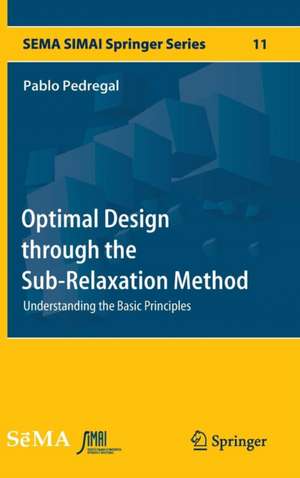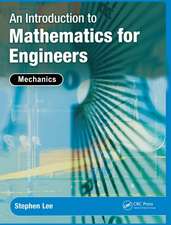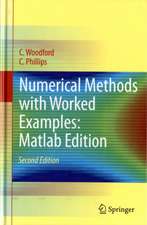Optimal Design through the Sub-Relaxation Method: Understanding the Basic Principles: SEMA SIMAI Springer Series, cartea 11
Autor Pablo Pedregalen Limba Engleză Hardback – 9 sep 2016
| Toate formatele și edițiile | Preț | Express |
|---|---|---|
| Paperback (1) | 379.48 lei 6-8 săpt. | |
| Springer International Publishing – 15 iun 2018 | 379.48 lei 6-8 săpt. | |
| Hardback (1) | 386.61 lei 6-8 săpt. | |
| Springer International Publishing – 9 sep 2016 | 386.61 lei 6-8 săpt. |
Din seria SEMA SIMAI Springer Series
- 24%
 Preț: 667.60 lei
Preț: 667.60 lei -
 Preț: 281.46 lei
Preț: 281.46 lei - 18%
 Preț: 721.81 lei
Preț: 721.81 lei - 18%
 Preț: 943.25 lei
Preț: 943.25 lei - 15%
 Preț: 630.88 lei
Preț: 630.88 lei - 15%
 Preț: 635.01 lei
Preț: 635.01 lei - 18%
 Preț: 774.83 lei
Preț: 774.83 lei - 15%
 Preț: 632.22 lei
Preț: 632.22 lei - 15%
 Preț: 630.57 lei
Preț: 630.57 lei - 18%
 Preț: 935.21 lei
Preț: 935.21 lei - 18%
 Preț: 937.89 lei
Preț: 937.89 lei - 18%
 Preț: 935.98 lei
Preț: 935.98 lei - 15%
 Preț: 658.88 lei
Preț: 658.88 lei - 15%
 Preț: 630.75 lei
Preț: 630.75 lei - 18%
 Preț: 992.04 lei
Preț: 992.04 lei -
 Preț: 395.47 lei
Preț: 395.47 lei - 15%
 Preț: 645.79 lei
Preț: 645.79 lei - 18%
 Preț: 731.59 lei
Preț: 731.59 lei - 15%
 Preț: 702.73 lei
Preț: 702.73 lei - 15%
 Preț: 648.42 lei
Preț: 648.42 lei - 15%
 Preț: 644.63 lei
Preț: 644.63 lei -
 Preț: 393.52 lei
Preț: 393.52 lei - 15%
 Preț: 645.49 lei
Preț: 645.49 lei - 15%
 Preț: 643.00 lei
Preț: 643.00 lei - 15%
 Preț: 654.77 lei
Preț: 654.77 lei -
 Preț: 385.08 lei
Preț: 385.08 lei - 18%
 Preț: 724.80 lei
Preț: 724.80 lei - 18%
 Preț: 952.40 lei
Preț: 952.40 lei - 15%
 Preț: 636.63 lei
Preț: 636.63 lei
Preț: 386.61 lei
Nou
Puncte Express: 580
Preț estimativ în valută:
74.00€ • 80.41$ • 62.20£
74.00€ • 80.41$ • 62.20£
Carte tipărită la comandă
Livrare economică 21 aprilie-05 mai
Preluare comenzi: 021 569.72.76
Specificații
ISBN-13: 9783319411583
ISBN-10: 3319411586
Pagini: 130
Ilustrații: XI, 130 p. 22 illus.
Dimensiuni: 155 x 235 x 10 mm
Greutate: 0.38 kg
Ediția:1st ed. 2016
Editura: Springer International Publishing
Colecția Springer
Seria SEMA SIMAI Springer Series
Locul publicării:Cham, Switzerland
ISBN-10: 3319411586
Pagini: 130
Ilustrații: XI, 130 p. 22 illus.
Dimensiuni: 155 x 235 x 10 mm
Greutate: 0.38 kg
Ediția:1st ed. 2016
Editura: Springer International Publishing
Colecția Springer
Seria SEMA SIMAI Springer Series
Locul publicării:Cham, Switzerland
Cuprins
1 Motivation and framework.- 2 Our approach.- 3 Relaxation through moments.- 4 Optimality.- 5 Simulation.- 6 Some extensions.- 7 Some technical proofs.
Recenzii
“The book is devoted to the study of optimal design problems … . The book is very well written, with problems clearly presented; it can provide a good starting point for any researcher who wants to approach the field of optimal design problems, from both the theoretical side and the applied side. The book could also be used as a textbook for master or graduate courses.” (Giuseppe Buttazzo, Mathematical Reviews, June, 2017)
Textul de pe ultima copertă
This book provides a comprehensive guide to analyzing and solving optimal design problems in continuous media by means of the so-called sub-relaxation method. Though the underlying ideas are borrowed from other, more classical approaches, here they are used and organized in a novel way, yielding a distinct perspective on how to approach this kind of optimization problems. Starting with a discussion of the background motivation, the book broadly explains the sub-relaxation method in general terms, helping readers to grasp, from the very beginning, the driving idea and where the text is heading. In addition to the analytical content of the method, it examines practical issues like optimality and numerical approximation. Though the primary focus is on the development of the method for the conductivity context, the book’s final two chapters explore several extensions of the method to other problems, as well as formal proofs. The text can be used for a graduate course in optimal design, even if the method would require some familiarity with the main analytical issues associated with this type of problems. This can be addressed with the help of the provided bibliography.
Caracteristici
Provides a detailed description of the various steps of the method, including analysis, optimality, and numerical simulation (for non-experts) Offers an excellent point of departure for further research Concise content and to-the-point discussions
















